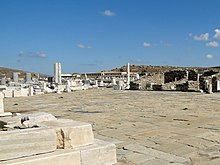User:Mr. Ibrahem/Agoraphobia
| Agoraphobia | |
|---|---|
 | |
| An ancient agora in Delos, Greece. One of the public spaces after which the condition is named. | |
| Specialty | Psychiatry |
| Symptoms | Anxiety in situations perceived to be unsafe, panic attacks[1][2] |
| Complications | Depression, substance use disorder[1] |
| Duration | > 6 months[1] |
| Causes | Genetic and environmental factors[1] |
| Risk factors | Family history, stressful event[1] |
| Differential diagnosis | Separation anxiety, posttraumatic stress disorder, major depressive disorder[1] |
| Treatment | Cognitive behavioral therapy[3] |
| Prognosis | Resolution in half with treatment[4] |
| Frequency | 1.7% of adults[1] |
Agoraphobia is an anxiety disorder characterized by symptoms of anxiety in situations where the person perceives their environment to be unsafe with no easy way to escape.[1] These situations can include open spaces, public transit, shopping centers, or simply being outside their home.[1] Being in these situations may result in a panic attack.[2] The symptoms occur nearly every time the situation is encountered and last for more than six months.[1] Those affected will go to great lengths to avoid these situations.[1] In severe cases people may become completely unable to leave their homes.[2]
Agoraphobia is believed to be due to a combination of genetic and environmental factors.[1] The condition often runs in families, and stressful or traumatic events such as the death of a parent or being attacked may be a trigger.[1] In the DSM-5 agoraphobia is classified as a phobia along with specific phobias and social phobia.[1][3] Other conditions that can produce similar symptoms include separation anxiety, post-traumatic stress disorder, and major depressive disorder.[1] Those affected are at higher risk of depression and substance use disorder.[1]
Without treatment it is uncommon for agoraphobia to resolve.[1] Treatment is typically with a type of counselling called cognitive behavioral therapy (CBT).[3][5] CBT results in resolution for about half of people.[4] Agoraphobia affects about 1.7% of adults.[1] Women are affected about twice as often as men.[1] The condition often begins in early adulthood and becomes less common in old age.[1] It is rare in children.[1] The term "agoraphobia" is from Greek ἀγορά, agorā́, meaning a "public square," and -φοβία, -phobía, meaning "fear."[6]
References[edit]
- ^ a b c d e f g h i j k l m n o p q r s t u American Psychiatric Association (2013), Diagnostic and Statistical Manual of Mental Disorders (5th ed.), Arlington: American Psychiatric Publishing, pp. 217–221, 938, ISBN 978-0890425558
- ^ a b c "Agoraphobia". PubMed Health. Archived from the original on 1 December 2015. Retrieved 11 August 2016.
- ^ a b c Wyatt, Richard Jed; Chew, Robert H. (2008). Wyatt's Practical Psychiatric Practice: Forms and Protocols for Clinical Use. American Psychiatric Pub. pp. 90–91. ISBN 9781585626878. Archived from the original on 2016-08-21.
- ^ a b Craske, MG; Stein, MB (24 June 2016). "Anxiety". Lancet. 388 (10063): 3048–3059. doi:10.1016/S0140-6736(16)30381-6. PMID 27349358.
- ^ Pompoli, A; Furukawa, TA; Imai, H; Tajika, A; Efthimiou, O; Salanti, G (13 April 2016). "Psychological therapies for panic disorder with or without agoraphobia in adults: a network meta-analysis". The Cochrane Database of Systematic Reviews. 4: CD011004. doi:10.1002/14651858.CD011004.pub2. PMC 7104662. PMID 27071857.
- ^ Elster, Charles Harrington (2009). Verbal Advantage: Ten Easy Steps to a Powerful Vocabulary. Diversified Publishing. p. PT717. ISBN 9780307560971. Archived from the original on 2016-08-21.
